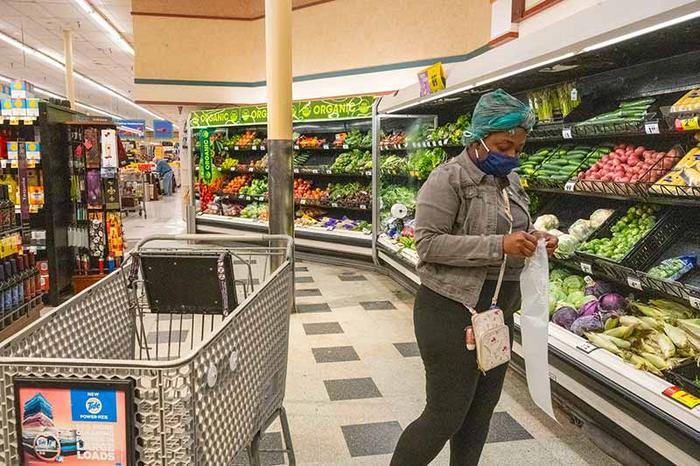The Supplemental Nutrition Assistance Program (SNAP) is the nation’s largest nutrition program, helping 41 million participants afford “nutritious food essential to health and well-being.”

Credit: University of Notre Dame/Barbara Johnston
The Supplemental Nutrition Assistance Program (SNAP) is the nation’s largest nutrition program, helping 41 million participants afford “nutritious food essential to health and well-being.”
But a new study from the University of Notre Dame found that SNAP participants in low-income households may not be able to meet the nutrition levels set by the Dietary Guidelines for Americans (DGA).
The case study set out to examine whether SNAP participants would be able to afford a healthy diet based on DGA’s recommended nutritional values. The DGA was created by the U.S. Departments of Agriculture and Health and Human Services to advise Americans on what they should eat and drink to meet nutrient needs, promote health and prevent disease.
“Healthy eating is a critical problem, especially within low-income communities where there’s a combination of economic and geographic constraints making healthy and affordable food less attainable,” said Nitesh Chawla, director of the Lucy Family Institute for Data and Society and the Frank M. Freimann Professor of Computer Science and Engineering at Notre Dame. “Individuals working within these constraints live in food deserts, and they have to consider multiple factors as they make decisions about their family’s diet.”
As a baseline, the research team used the maximum SNAP allotment offered for a single person in Indiana as of October 2021, which was $250 per month. They divided this amount by day to determine what a person’s daily budget would be. Then the team created a linear programming model that considers product nutrition and price for items available within a nationwide grocery store chain in South Bend.
“We found that people essentially make trade-offs based on the information they have to try to stretch their funds and maximize nutrition,” said Ronald Metoyer, professor of computer science and engineering and vice president and associate provost for teaching and learning. “Our idea for this study was to use computation to aggregate all of the relevant information (e.g., inventory, prices and nutritional content) and use optimization to make those choices.”
Researchers took into consideration the cost per serving for a meal and the different diet guidelines for men and women ages 31-50, while also minimizing the cost of the diet however possible. Although they found it was possible to create a realistic woman’s diet that fits the monetary allotment of SNAP and the nutritional needs of the DGA, it was not possible to do the same for men.
The team also analyzed the trade-off between cost and nutritional value specifically for nutrients that Americans tend to overconsume: sodium, saturated fat and added sugars. To do this, they set the DGA’s parameters aside and selected only the cheapest food options to meet the SNAP budget. The researchers found a direct correlation between sodium and cost — as the cost of groceries decreases, the amount of sodium consumed increases.
Researchers also noted that the hardest DGA parameters to meet on a SNAP budget were daily vitamin and mineral intake needs.
“What we found was vitamins and minerals are very difficult to actually hit the dietary guidelines on,” said Joe Germino, a doctoral student in the Lucy Institute’s DIAL Lab who is advised by Chawla. “You have to make a conscious decision to go and find food items that are cheap enough and actually match your budget. It just adds another layer of complexity to an already difficult problem when you’re living in a food desert.”
Census data has identified 11 areas in St. Joseph County that can be identified as food deserts, or where a significant amount of people live more than a mile from the nearest supermarket. Residents living in and around the area have to consider the distance to full-service grocery stores as well as their access to transportation to purchase healthy foods.
These barriers are even more difficult to overcome for low-income households, which could create a higher reliance on alternative food sources such as food pantries. Although the per-person budget for SNAP recipients has increased since this study was conducted, due to other economic constraints such as inflation researchers believe that the results still apply for those relying on SNAP support today.
“The reason we chose South Bend is because we have areas that are considered food deserts and we are seeing this lack of food access happening within our own community,” said Annalisa Szymanski, a Lucy Graduate Scholar who is advised by Metoyer and a co-author on the study.
The study published in Frontiers in Big Data is just one way Notre Dame researchers are leveraging technology to tackle this national challenge of food access and insecurity through the Food Information Networks (FINS) project. Led by Metoyer, FINS is funded by the National Institute of Food and Agriculture. The project aims to thoroughly understand the barriers to access for healthy food, develop technological supports, and deploy and study interventions in South Bend and Detroit.
The project will culminate with an app that employs optimization methods to recommend and suggest healthier food items to people based on their dietary goals and their budgets. In the spring, researchers will pilot a version of the app in Rum Village, a neighborhood of South Bend. The goal is to test the app to see how that solution helps overcome transportation constraints. The pilot will partner with local Walmart grocery stores.
“Through the pilot, we’re testing to see if we promote different suggestions for healthier food products in the app, will that influence how people are eating? Or what if they know there is a healthier product on sale?” Szymanski said. “We want to see how this technology, when considering both dietary goals and budget, could realistically impact eating habits.”
The researchers are also looking into how the FINS project could leverage artificial intelligence, such as large language models, to create personalized diet recommendations.
Contact: Brandi Wampler, associate director of media relations, 574-631-2632, [email protected]
Journal
Frontiers in Big Data
DOI
10.3389/fdata.2023.1086212
Article Title
A community focused approach toward making healthy and affordable daily diet recommendations
Article Publication Date
6-Nov-2023




